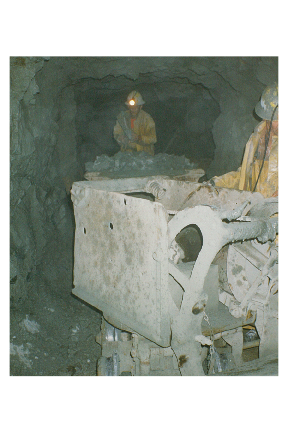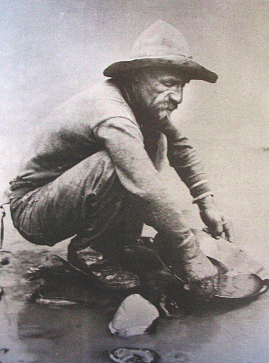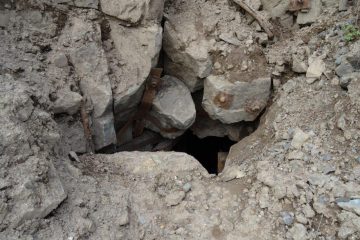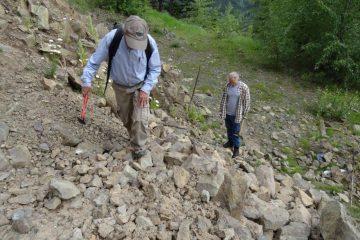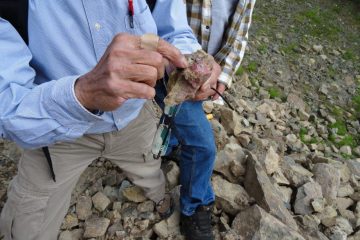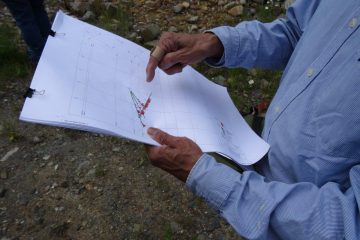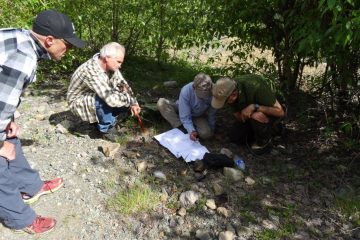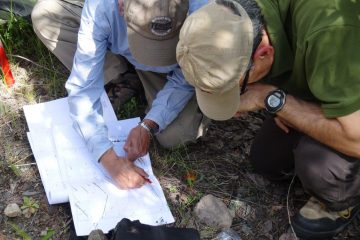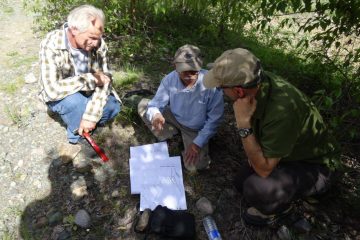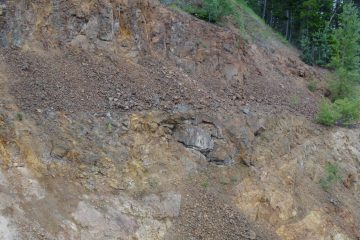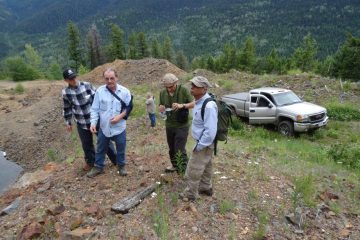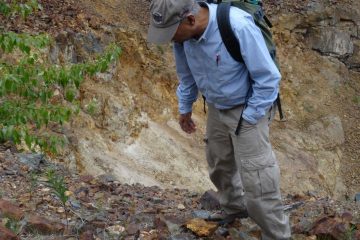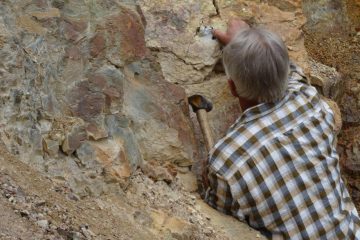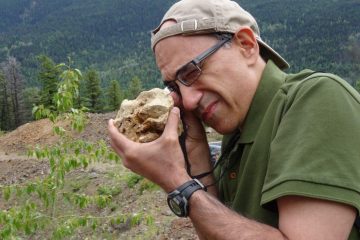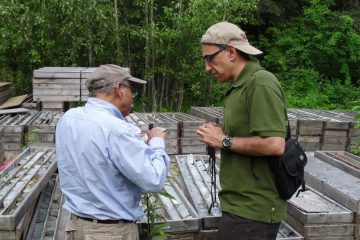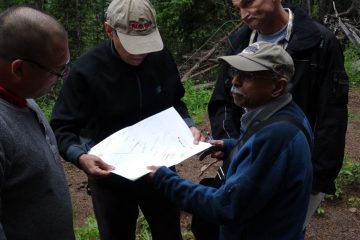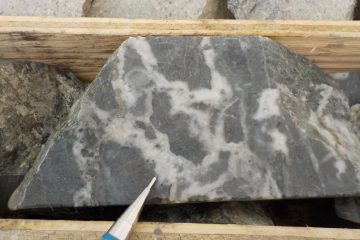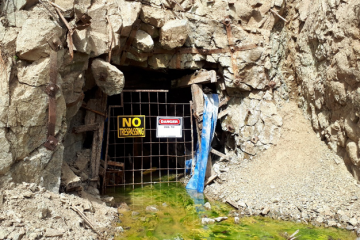Overview
The Brett Epithermal Gold Project is Ximen’s primary precious metals project. Since 2013, Ximen has owned and controlled 100% of this 20,025 ha. epithermal gold district, which is situated in southern British Columbia near the city of Vernon. Historical intercepts from the Brett Gold property include up to 168 g/t over 1.3 m core length, with visible gold being common. In 1995–96, 291 tonnes of surface trench samples graded at 28 g/t gold and 64 g/t silver.

~20,000 hectares
Epithermal gold deposits offer some of the largest and highest grade gold mines in the world. Epithermal deposits are the products of large-scale hydrothermal convective systems driven by magmatic heat in the upper 5–10 km of the Earth’s crust. There are two classes of epithermal deposits which can be discriminated in terms of their geologic environments, alteration mineralogy, and fluid chemistry: (1) low-sulfidation epithermal deposits, and (2) high-sulfidation epithermal deposits. The Brett property has the geological characteristics of the low-sulfidation type.

This property has undergone several geochemical surveys since 1977, as well as ground geophysical surveys, trenching and underground mine exploration.
Ximen’s current exploration plan for the Brett Gold Project includes underground development to support drilling of the Main Zone and parallel zones, and selected surface drilling and geochemistry following the compilation of historical results.
The Brett Gold Project has multiple gold-bearing zones, with both high-grade and low-grade gold mineralization, including:
- the Main Zone—The primary site of Ximen’s exploration efforts, the Main Zone’s high-grade gold domains (shoots) are localized along a fault. These shoots are associated with silicification and disrupted vein quartz, with bladed calcite in veins that signifies boiling zones in an epithermal environment. All of this indicates potential for rich zones of high-grade gold mineralization.
- In 1994, a 250 m adit was driven to provide underground access for mining the Main Zone but commercial production was not achieved and the project subsequently changed ownership.
- the RW Pit, excavated on the Main Zone, produced 291 tonnes that were shipped to the Trail Cominco smelter in 1996 and graded an average of 28 g/tonne Au and 64 g/tonne Ag.
- the Stockwork Zone—This zone of mineralized quartz-carbonate hydrothermal breccia, localized along a margin of feldspar porphyry dike, is parallel to the Main Zone and 100 m east. Hole 04-12, intercepted 168.5 g/t over 1.3 m core length.
- the Gossan Zone (750 m x 50 m)—The Gossan is a large, fault-bounded zone of pervasive silica-clay-pyrite alteration, associated with a magnetic low feature that is 300 m wide, and a 1 km long, north-south trending IP chargeability anomaly. The eastern limit of the Gossan zone coincides with a fault that separates Eocene rocks to the west from Jurassic rocks to the east and is thought to be a district-scale, graben-bounding structure and pathway for mineralizing fluids. Multiple zones of silicification, clay alteration, brecciation and pyrite mineralization up to 42 m in core length have been intersected in drilling. Although gold values intersected to date are low, a strong pathfinder geochemical signature is evident with elevated values for Hg, As, Tl and Sb from drilling. All of this indicates potential for bulk-tonnage low-grade style gold mineralization.
- the Border Zone (250 m x 100–200 m)—This is a newly discovered zone where hole 14-13 intersected 7.20 g/t gold over 5 m core length (including 1.5 m grading 16.70 g/t Au) that is associated with elevated values for silver, arsenic, mercury, molybdenum, antimony, selenium, tellurium, and thallium. This intercept is located approximately 50 m west of the Main Zone. The area corresponds to a large magnetic low anomaly.
- the 490 Gold Zone—located 85m east of the Main Zone, is a subparallel structure to the Main Zone. The 490 Zone can be traced on surface for several hundred metres and was tested by drilling in 2014 for only a 100m strike length near the southern portion of its known strike extent. In addition to intersecting discrete epithermal veins, several drill holes intersected broader intervals of strong silica-flooding and low-grade gold mineralization within more permeable tuffaceous and volcanic breccia units. High grade gold values from structurally controlled targets include 0.90m grading 34.18 g/t Au in hole 14-01 and 1.0m grading 20.5 g/t Au in hole 14-05. Bulk tonnage-style intercepts include 16.55 m of 1.88 g/t Au in hole 14-05. Also the end of hole 14-02 graded 0.43 g/t Au over 22 meters indicating a zone that remains untested at depth.
- the East Zone—Historic soil geochemistry with values up to 765 ppb Au attracted the interest of previous workers, leading to the discovery of visible gold in an outcrop of basaltic volcaniclastic rocks with quartz-carbonate veining. In 2014, a Au-Ag-Hg-Sb-Tl soil anomaly was defined over the East Zone, with maximum gold values of 290 ppb and 243 ppb Au. The anomaly appears to be a surface expression of a flat lying tuffaceous horizon. The tuffaceous horizon has not been drilled near the bounding fault structures. This is another target for bulk tonnage style mineralization.
- the Brewer Zone—two quartz veins that contain base-metal minerals, the “Brewer Veins”, have been identified east of the fault zone associated with the Gossan Zone. These veins and have potential for lode gold-silver mineralization.
Understanding the Brett Gold Project
Summary of Work Done by Ximen
Work Planned for
2021:
- Conduct additional surface diamond drilling and geophysical survey
- Continue to permit underground exploration program
2020
- Received approval for surface drilling
2019
- Began the permitting process for underground exploration development.
2016
- Diamond drilling, including 16 holes at 2364 m
2014
- Geological mapping and 3D interpretation
- Soil and rock geochemistry and biogeochemistry
- Geophysical surveys, including ground IP and magnetometer/VLF-EM
- Diamond drilling, including 13 holes at 2977 m
Deposit model
The Brett Gold Project displays characteristics of low-sulphidation epithermal gold-silver deposits. It is hosted in the Eocene Penticton Group volcanic rocks. Gold was deposited in dilational zones along the faults and at structural intersections with more permeable volcaniclastic horizons. Both “lode” (high grade) and “disseminated” (low-grade) mineralization styles are present and being targeted.
Gold mineralization
High-grade gold
High-grade gold (lode mineralization style) occurs in quartz-carbonate hydrothermal breccias, veins, and in fragments of vein quartz and wall rock within fault structures. This style is common in the Main Zone and Stockwork Zone.
Visible gold, electrum, and argentite have been observed and coarse visible gold is not uncommon on the property. Additionally, Ximen has identified coarse free gold in clay and sand gouge zones.
Samples from the Brett Gold Project have assayed up to hundreds of grams per tonne (several ounces per ton) of both gold and silver over significant widths in drill holes and trenches. To date, gold mineralization has been identified over a strike length of 650 m and vertical interval of 85 m on the Main Zone.
Low-grade gold
Low-grade gold mineralization (disseminated mineralization style) is associated with extensive zones of pervasive alteration in volcaniclastic horizons. At Brett Gold, this includes in the Gossan Zone and another area located west of the Main Zone.

Idealized cross section through the Brett deposit showing the geometry of the mineralized fault system.

